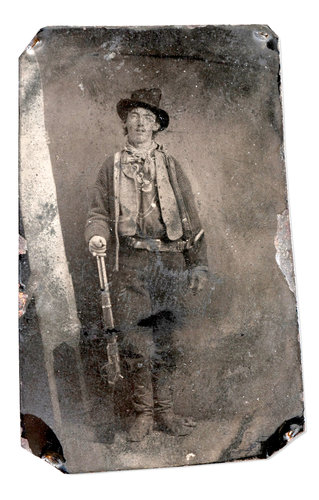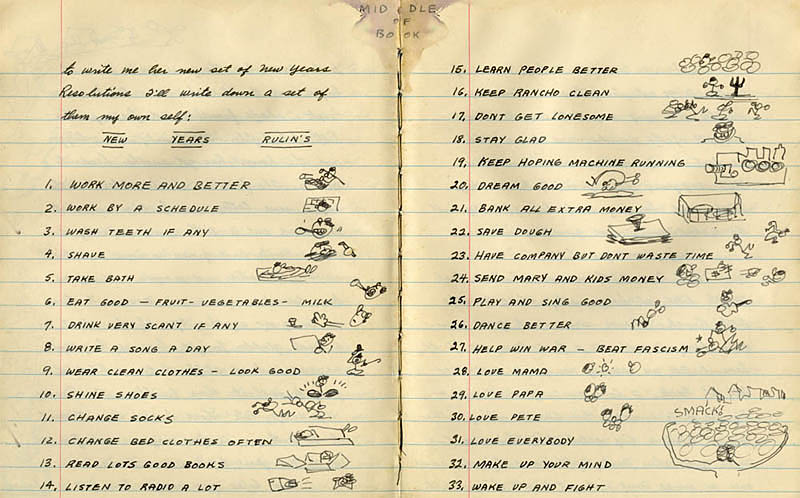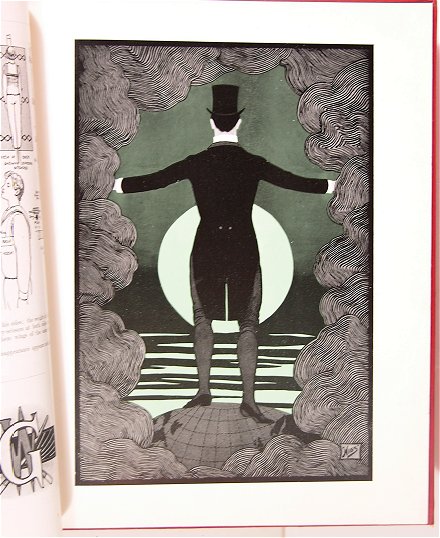
Eve Kahn, resident Antiques columnist for The New York Times, reflects on the 6 most intriguing auctions of 2011.
Follow
Eve Kahn, resident Antiques columnist for The New York Times, reflects on the 6 most intriguing auctions of 2011.
FollowWe’re back from a brief hiatus to celebrate the holidays with our nearest and dearest. We hope you all had happy and healthy holidays, and are ready to make some changes in 2012!
Personally, I haven’t yet finished my own list of resolutions, but perhaps I’ll find something inspiration in Woody Guthrie‘s from 1942 (though, most likely not):

Walnutts FAQ’s is a series of common questions… and their answers.
Q. Fairly frequently, I see you post about “laid” paper. What is that?
A. All paper made before about 1800 was “laid paper.” The name comes from a ribbed texture imparted to the sheet by the manufacturing process. In the 19th century, its use diminished as it was largely supplanted by “wove paper.”
In pre-mechanical papermaking (from the 12th century into the 1800s), the laid pattern was produced by the wire sieve in the rectangular mold used to produce single sheets of paper. A worker would dip the mold into a vat containing diluted linen pulp, then lift it out, tilt it to spread the pulp evenly over the sieve, and, as the water drained out between the wires, shake the mold to lock the fibers together. In the process, the pattern of the wires in the sieve was imparted to the sheet of paper. Any authentic paper document or manuscript dated before 1800 will be executed on “laid paper” – when held up to a light source, a pattern of crosshatch lines will be visible within the structure of the paper sheet.
FollowWhen I first began at Walnutts, for the purposes of this blog, actually, I was relatively new to the world of “antiques.” While estate and tag sales are a regular fixture of my weekend, there is still a lot for me to learn when it comes to collecting. The first thing I learned how to distinguish, however, was vintage vs. antique.
Now, to me, they were synonymous. The only difference I believed to exist was that “vintage” had a friendlier tone to it. I wouldn’t mind if someone came up to me and said, “I love that purse you’re carrying! It’s so vintage!” I would mind however if they said, “It’s so… antique.” So, to begin this journey, I first looked up the definition of each.
Definition:
 nd
nd mia : v
mia : v num, grapes + d
num, grapes + d mere, to take off (d
mere, to take off (d , de- + emere, to obtain; see em- in Indo-European roots).]
, de- + emere, to obtain; see em- in Indo-European roots).]VS.
antique [an-teek]
Hmm. You can understand my confusion. Next, I took to the Internet. A quick Google search brought up a very lively discussion, on a multitude of fronts, over the distinctions between “vintage” and “antique.” Thankfully, one of my favorite sites, Apartment Therapy, outlined the differences rather nicely:
What is antique?
According to Merriam Webster, an antique is “a relic or object of ancient times” or “a work of art, piece of furniture, or decorative object made at an earlier period and according to various customs laws at least 100 years ago.” Ruby Lane, an online marketplace of independent antique and collectible shops, offers a similar definition, explaining, “Most authorities consider the actual definition of the term ‘antique’ to mean an age of at least 100 years. If an item is not definitively datable to 100 or more years in age, it should not be directly referred to as an antique.”What is vintage?
If antiques are things that are 100 years old or older, what are vintage pieces? The defnition of vintage is trickier. According to Merriam Webster, the term vintage relates primarily to wine and is an altered form of the French word vendage, meaning “the grapes picked during a season.” One of its secondary definitions is “a period of origin or manufacture” (e.g., a vintage 1960s Mercedes) or “length of existence: age.” Ruby Lane provides a much more helpful explanation, noting that “an item described as ‘vintage’ should speak of the era in which it was produced. Vintage can mean an item is of a certain period of time, as in “vintage 1950′s” but it can also mean (and probably always should) that the item exhibits the best of a certain quality, or qualities, associated with or belonging to that specific era. In other words, for the term vintage to accurately apply to it, an item should be somewhat representational and recognizable as belonging to the era in which it was made.” Ruby Lane also suggests that ‘vintage’ should not be used in reference to objects less than 20 years old.
Essentially, it not only has to do with age (antique being over 100 years old, vintage for items 20+ years old), but more so has to do with syntactical usage of each term. Now, I do realize that majority of the readers of this site have no difficulty in defining and distinguishing the two. But as someone learning, I feel as though I can better navigate the “world of antiques” and understand categorizations and valuations of objects.
I look forward to continue this learning process as we continue to build and fill up the Walnutts site! The wealth of resources already contained herein have afforded me so many outlets to expand my education.
FollowThe world of magic has fascinated for centuries. With the popularity of the circus rising in the mid-19th to early-20th centuries in America, magicians became celebrity figures, celebrated and revered. Pictures above is a wonderful and very rare, 1910-11 volume of The Magician Annual. The book was compiled and edited by Will Goldston, and published by The Magician Ltd. It was a fascinating and quite beautiful 102-page volume that included three colored plates and over three hundred illustrations. Bound in its original, elaborate, pictorial red cloth covers, the front board included an image of an Indian magician.
The book has a broad range of contents, from stage juggling, to the history of playing, pocket tricks, illusions, and biographical information on various magicians of the Period. It is filled with a variety of interesting articles, from trick descriptions to pattern suggestions, from biographical information to theory. Among others, there is a trick contribution by Harry Houdini.
The Table of Contents includes:
The Scribe, The Failure, and The Magician (JOHN KEYMAN)
Amateur Conjurer’s Accessories (GEORGE JOHNSON)
The Magic of Suggestion (PROFESSOR HOFFMANN)
New Patter for Popular Problems (WOOLFE CLYNE)
Wine v. Water (CHRIS VAN BERN)
Telepathic Materialization (MAX STERLING)
Original Tricks (“ELLIOT”)
Magicians I Have Met (WILL GOLDSTON)
Some Clever Box Mysteries Exposed (JAY GEE)

Original Stage Mysteries (COLLINS & BRETMA)
The League of Magicians (WILL GOLDSTON)
Something to Startle the Public (EDGAR TURNER)
Other People’s Ideas (THE EDITOR)
Fêke Mediums (“KATCHEM”)
Can the Dead Speak? (HENRY BYATT)
Spanish Maiden Escape (HARRY HOUDINI)
Quick Change Secrets (LEE LAURIE)
Mysterious Stage Illusions (WILL GOLDSTON)
Other Coloured Plates
The book’s editor, Will Goldston was born Wolf Goldstone in Liverpool, England. He was of Jewish parentage, and at age of 11 or 12 became inspired by a box of tricks given to him as a present. In 1892, Goldston was studying with Prof. Alexander and reading Hoffmann’s Modern Magic. He debuted as apprentice at age 17 in 1898. He was also known as “Carl Devo” (circa 1898-1907), initially with Black Art. He moved from Professional Magician to a Professional Magic Dealer and managed the Conjuring, Theatrical, and Entertainment Departments at Gamages 1905-14. Goldston founded “The Magicians’ Club” in 1911, serving as Treasurer throughout but running it as a one-man self-serving club, until it passed into limbo during WW II. He was also the owner-manager of Aladdin House (Will Goldston Ltd) 1914-48 in London.
The majority of the text is instruction, not only in the mechanics of various magic tricks and illusions, but more importantly, guidance for the would-be magician regarding stage presence, conduct before an audience, timing, misdirection and general demeanor. The remainder is biographical and historical material on magicians and their craft. The world of magicians have always found their place in books, past and present, and this was an exemplary tome of the tricks of the trade.
Follow